Input interpretation

NO_2 nitrogen dioxide ⟶ N_2O_4 dinitrogen tetroxide
Balanced equation
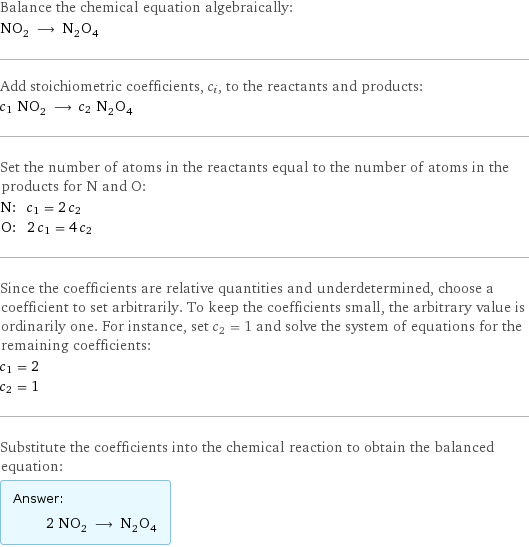
Balance the chemical equation algebraically: NO_2 ⟶ N_2O_4 Add stoichiometric coefficients, c_i, to the reactants and products: c_1 NO_2 ⟶ c_2 N_2O_4 Set the number of atoms in the reactants equal to the number of atoms in the products for N and O: N: | c_1 = 2 c_2 O: | 2 c_1 = 4 c_2 Since the coefficients are relative quantities and underdetermined, choose a coefficient to set arbitrarily. To keep the coefficients small, the arbitrary value is ordinarily one. For instance, set c_2 = 1 and solve the system of equations for the remaining coefficients: c_1 = 2 c_2 = 1 Substitute the coefficients into the chemical reaction to obtain the balanced equation: Answer: | | 2 NO_2 ⟶ N_2O_4
Structures

⟶
Names

nitrogen dioxide ⟶ dinitrogen tetroxide
Reaction thermodynamics
Enthalpy
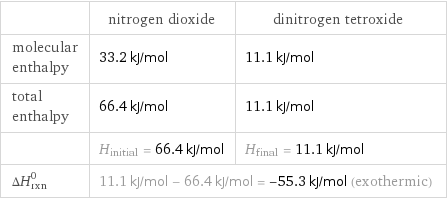
| nitrogen dioxide | dinitrogen tetroxide molecular enthalpy | 33.2 kJ/mol | 11.1 kJ/mol total enthalpy | 66.4 kJ/mol | 11.1 kJ/mol | H_initial = 66.4 kJ/mol | H_final = 11.1 kJ/mol ΔH_rxn^0 | 11.1 kJ/mol - 66.4 kJ/mol = -55.3 kJ/mol (exothermic) |
Gibbs free energy
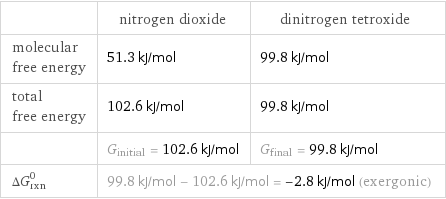
| nitrogen dioxide | dinitrogen tetroxide molecular free energy | 51.3 kJ/mol | 99.8 kJ/mol total free energy | 102.6 kJ/mol | 99.8 kJ/mol | G_initial = 102.6 kJ/mol | G_final = 99.8 kJ/mol ΔG_rxn^0 | 99.8 kJ/mol - 102.6 kJ/mol = -2.8 kJ/mol (exergonic) |
Entropy
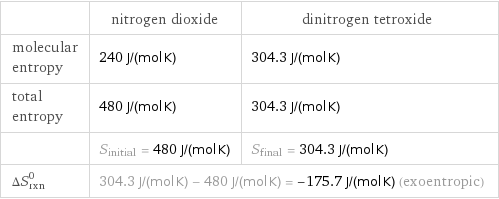
| nitrogen dioxide | dinitrogen tetroxide molecular entropy | 240 J/(mol K) | 304.3 J/(mol K) total entropy | 480 J/(mol K) | 304.3 J/(mol K) | S_initial = 480 J/(mol K) | S_final = 304.3 J/(mol K) ΔS_rxn^0 | 304.3 J/(mol K) - 480 J/(mol K) = -175.7 J/(mol K) (exoentropic) |
Equilibrium constant
![Construct the equilibrium constant, K, expression for: NO_2 ⟶ N_2O_4 Plan: • Balance the chemical equation. • Determine the stoichiometric numbers. • Assemble the activity expression for each chemical species. • Use the activity expressions to build the equilibrium constant expression. Write the balanced chemical equation: 2 NO_2 ⟶ N_2O_4 Assign stoichiometric numbers, ν_i, using the stoichiometric coefficients, c_i, from the balanced chemical equation in the following manner: ν_i = -c_i for reactants and ν_i = c_i for products: chemical species | c_i | ν_i NO_2 | 2 | -2 N_2O_4 | 1 | 1 Assemble the activity expressions accounting for the state of matter and ν_i: chemical species | c_i | ν_i | activity expression NO_2 | 2 | -2 | ([NO2])^(-2) N_2O_4 | 1 | 1 | [N2O4] The equilibrium constant symbol in the concentration basis is: K_c Mulitply the activity expressions to arrive at the K_c expression: Answer: | | K_c = ([NO2])^(-2) [N2O4] = ([N2O4])/([NO2])^2](../image_source/cd8efeb04469f7ecda7844173a1981cc.png)
Construct the equilibrium constant, K, expression for: NO_2 ⟶ N_2O_4 Plan: • Balance the chemical equation. • Determine the stoichiometric numbers. • Assemble the activity expression for each chemical species. • Use the activity expressions to build the equilibrium constant expression. Write the balanced chemical equation: 2 NO_2 ⟶ N_2O_4 Assign stoichiometric numbers, ν_i, using the stoichiometric coefficients, c_i, from the balanced chemical equation in the following manner: ν_i = -c_i for reactants and ν_i = c_i for products: chemical species | c_i | ν_i NO_2 | 2 | -2 N_2O_4 | 1 | 1 Assemble the activity expressions accounting for the state of matter and ν_i: chemical species | c_i | ν_i | activity expression NO_2 | 2 | -2 | ([NO2])^(-2) N_2O_4 | 1 | 1 | [N2O4] The equilibrium constant symbol in the concentration basis is: K_c Mulitply the activity expressions to arrive at the K_c expression: Answer: | | K_c = ([NO2])^(-2) [N2O4] = ([N2O4])/([NO2])^2
Rate of reaction
![Construct the rate of reaction expression for: NO_2 ⟶ N_2O_4 Plan: • Balance the chemical equation. • Determine the stoichiometric numbers. • Assemble the rate term for each chemical species. • Write the rate of reaction expression. Write the balanced chemical equation: 2 NO_2 ⟶ N_2O_4 Assign stoichiometric numbers, ν_i, using the stoichiometric coefficients, c_i, from the balanced chemical equation in the following manner: ν_i = -c_i for reactants and ν_i = c_i for products: chemical species | c_i | ν_i NO_2 | 2 | -2 N_2O_4 | 1 | 1 The rate term for each chemical species, B_i, is 1/ν_i(Δ[B_i])/(Δt) where [B_i] is the amount concentration and t is time: chemical species | c_i | ν_i | rate term NO_2 | 2 | -2 | -1/2 (Δ[NO2])/(Δt) N_2O_4 | 1 | 1 | (Δ[N2O4])/(Δt) (for infinitesimal rate of change, replace Δ with d) Set the rate terms equal to each other to arrive at the rate expression: Answer: | | rate = -1/2 (Δ[NO2])/(Δt) = (Δ[N2O4])/(Δt) (assuming constant volume and no accumulation of intermediates or side products)](../image_source/882260f476ea7be6a2244aa18f58fa18.png)
Construct the rate of reaction expression for: NO_2 ⟶ N_2O_4 Plan: • Balance the chemical equation. • Determine the stoichiometric numbers. • Assemble the rate term for each chemical species. • Write the rate of reaction expression. Write the balanced chemical equation: 2 NO_2 ⟶ N_2O_4 Assign stoichiometric numbers, ν_i, using the stoichiometric coefficients, c_i, from the balanced chemical equation in the following manner: ν_i = -c_i for reactants and ν_i = c_i for products: chemical species | c_i | ν_i NO_2 | 2 | -2 N_2O_4 | 1 | 1 The rate term for each chemical species, B_i, is 1/ν_i(Δ[B_i])/(Δt) where [B_i] is the amount concentration and t is time: chemical species | c_i | ν_i | rate term NO_2 | 2 | -2 | -1/2 (Δ[NO2])/(Δt) N_2O_4 | 1 | 1 | (Δ[N2O4])/(Δt) (for infinitesimal rate of change, replace Δ with d) Set the rate terms equal to each other to arrive at the rate expression: Answer: | | rate = -1/2 (Δ[NO2])/(Δt) = (Δ[N2O4])/(Δt) (assuming constant volume and no accumulation of intermediates or side products)
Chemical names and formulas
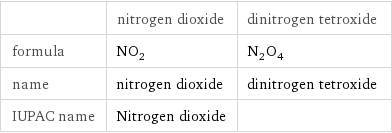
| nitrogen dioxide | dinitrogen tetroxide formula | NO_2 | N_2O_4 name | nitrogen dioxide | dinitrogen tetroxide IUPAC name | Nitrogen dioxide |
Substance properties
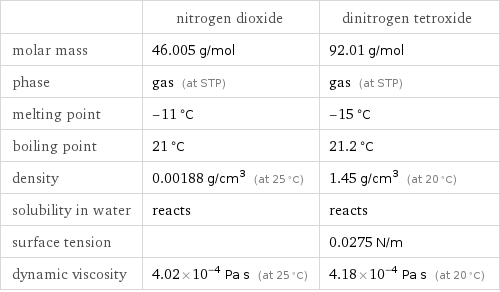
| nitrogen dioxide | dinitrogen tetroxide molar mass | 46.005 g/mol | 92.01 g/mol phase | gas (at STP) | gas (at STP) melting point | -11 °C | -15 °C boiling point | 21 °C | 21.2 °C density | 0.00188 g/cm^3 (at 25 °C) | 1.45 g/cm^3 (at 20 °C) solubility in water | reacts | reacts surface tension | | 0.0275 N/m dynamic viscosity | 4.02×10^-4 Pa s (at 25 °C) | 4.18×10^-4 Pa s (at 20 °C)
Units
